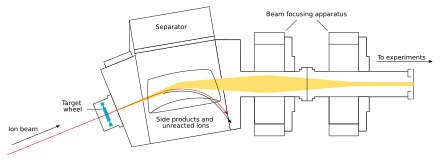Copernicium
Copernicium was first created in February 1996 by the GSI Helmholtz Centre for Heavy Ion Research near Darmstadt, Germany.
[20] The definition by the IUPAC/IUPAP Joint Working Party (JWP) states that a chemical element can only be recognized as discovered if a nucleus of it has not decayed within 10−14 seconds.
This value was chosen as an estimate of how long it takes a nucleus to acquire electrons and thus display its chemical properties.
[j] Copernicium was first created on 9 February 1996, at the Gesellschaft für Schwerionenforschung (GSI) in Darmstadt, Germany, by Sigurd Hofmann, Victor Ninov et al.[52] This element was created by firing accelerated zinc-70 nuclei at a target made of lead-208 nuclei in a heavy ion accelerator.
[53] This reaction was repeated at RIKEN using the Search for a Super-Heavy Element Using a Gas-Filled Recoil Separator set-up in 2004 and 2013 to synthesize three further atoms and confirm the decay data reported by the GSI team.
[54][55] This reaction had also previously been tried in 1971 at the Joint Institute for Nuclear Research in Dubna, Russia to aim for 276Cn (produced in the 2n channel), but without success.
[56] The IUPAC/IUPAP Joint Working Party (JWP) assessed the claim of copernicium's discovery by the GSI team in 2001[57] and 2003.
[60] This decision was based on the confirmation of the decay properties of daughter nuclei as well as the confirmatory experiments at RIKEN.
While initial experiments aimed to assign the produced nuclide with its observed long half-life of 3 minutes based on its chemical behaviour, this was found to be not mercury-like as would have been expected (copernicium being under mercury in the periodic table),[61] and indeed now it appears that the long-lived activity might not have been from 283Cn at all, but its electron capture daughter 283Rg instead, with a shorter 4-second half-life associated with 283Cn.
Although widely used in the chemical community on all levels, from chemistry classrooms to advanced textbooks, the recommendations were mostly ignored among scientists in the field, who either called it "element 112", with the symbol of E112, (112), or even simply 112.
[1] After acknowledging the GSI team's discovery, the IUPAC asked them to suggest a permanent name for element 112.
[61][64] On 14 July 2009, they proposed copernicium with the element symbol Cp, after Nicolaus Copernicus "to honor an outstanding scientist, who changed our view of the world".
On 19 February 2010, the 537th anniversary of Copernicus' birth, IUPAC officially accepted the proposed name and symbol.
Several radioactive isotopes have been synthesized in the laboratory, either by fusing two atoms or by observing the decay of heavier elements.
Copernicium is the tenth and last member of the 6d series and is the heaviest group 12 element in the periodic table, below zinc, cadmium and mercury.
[1] In opposition to the earlier suggestion,[89] ab initio calculations at the high level of accuracy[90] predicted that the chemistry of singly-valent copernicium resembles that of mercury rather than that of the noble gases.
The latter result can be explained by the huge spin–orbit interaction which significantly lowers the energy of the vacant 7p1/2 state of copernicium.
The fact that the 6d electrons participate more readily in chemical bonding means that once copernicium is ionized, it may behave more like a transition metal than its lighter homologues, especially in the possible +4 oxidation state.
[1] The formation of thermodynamically stable copernicium(II) and (IV) fluorides would be analogous to the chemistry of xenon.
This results from the effects of copernicium's higher atomic weight being cancelled out by its larger interatomic distances compared to mercury.
[3] Some calculations predicted copernicium to be a gas at room temperature due to its closed-shell electron configuration,[93] which would make it the first gaseous metal in the periodic table.
[1][88] A 2019 calculation agrees with these predictions on the role of relativistic effects, suggesting that copernicium will be a volatile liquid bound by dispersion forces under standard conditions.
[96][97] 2019 calculations then suggested that in fact copernicium has a large band gap of 6.4 ± 0.2 eV, which should be similar to that of the noble gas radon (predicted as 7.1 eV) and would make it an insulator; bulk copernicium is predicted by these calculations to be bound mostly by dispersion forces, like the noble gases.
[98] Interest in copernicium's chemistry was sparked by predictions that it would have the largest relativistic effects in the whole of period 7 and group 12, and indeed among all 118 known elements.
[1] Copernicium is expected to have the ground state electron configuration [Rn] 5f14 6d10 7s2 and thus should belong to group 12 of the periodic table, according to the Aufbau principle.
As such, it should behave as the heavier homologue of mercury and form strong binary compounds with noble metals like gold.
Experiments were performed with the simultaneous formation of mercury and radon radioisotopes, allowing a comparison of adsorption characteristics.
[99] Given this uncertainty, between April–May 2006 at the JINR, a FLNR–PSI team conducted experiments probing the synthesis of this isotope as a daughter in the nuclear reaction 242Pu(48Ca,3n)287Fl.
)[100] In this experiment, two atoms of copernicium-283 were unambiguously identified and the adsorption properties were interpreted to show that copernicium is a more volatile homologue of mercury, due to formation of a weak metal-metal bond with gold.
[99] These experiments also allowed the first experimental estimation of copernicium's boiling point: 84+112−108 °C, so that it may be a gas at standard conditions.


